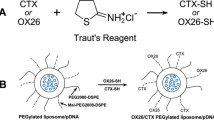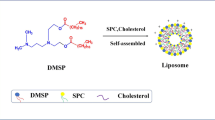Abstract
Purpose. To develop and evaluate a novel artificial lipoprotein delivery system for in vitro gene transfection in human glioma cells.
Method. Nanoemulsion was formulated with similar lipid compositions present in natural lipoproteins. The oil phase of nanoemulsion was composed of triolein (70%), egg phosphatidylcholine (22.7%), lysophosphatidylcholine (2.3%), cholesterol oleate (3.0%), and cholesterol (2.0%). To replace the surface protein as in natural lipoprotein, poly-L-lysine was modified to add palmitoyl chains at a basic condition and was incorporated onto the nanoemulsion particles through hydrophobic interaction. A model plasmid DNA, pSV-β-Gal containing a reporter gene for β-galactosidase was carried by the nanoemulsion/poly-L-lysine particles. The charge variation of so-formed complex was examined by agarose gel electrophoresis and zeta potential measurement. In vitro transfection was conducted on human SF-767 glioma cell line using this new system. After standard X-Gal staining, transfected cells were observed under light microscope. The effect of chloroquine on the transfection was examined and, finally, the cytotoxicity of this new system was evaluated in comparison with commercial Lipofectamine™ gene transfection system.
Results. The plasmid DNA was effectively carried by this artificial lipoprotein delivery system and the reporter gene was expressed in the glioma cells. Transfection efficiency was significantly increased by the treatment of chloroquine, indicating that endocytosis possibly was the major cellular uptake pathway. Compared to Lipofectamine™ system, this new delivery system demonstrated similar transfection efficiency but a much lower cytotoxicity. In the experiment, the cell viability showed up to 75% using this system compared to only 24% using Lipofectamine™ system.
Conclusion. A new artificial lipoprotein delivery system was developed for in vitro gene transfection in tumor cells. The new system showed similar transfection efficiency but a much lower cytotoxicity compared with commercial Lipofectamine system.
Similar content being viewed by others
REFERENCES
S. Lehrman. Virus treatment questioned after gene therapy death. Nature 401:517-518 (1999).
E. Marshall. Gene therapy death prompts review of adenovirus vector. Science 286:2244-2245 (1999).
W. T. Godbey, and A. G. Mikos. Recent progress in gene delivery using non-viral transfer complexes. J. Control. Release 72:115-125 (2001).
F. Liu and L. Huang. Development of non-viral vectors for systemic gene delivery. J. Control. Release 78:259-266 (2002).
S. Han, R. I. Mahato, Y. K. Sung, and S. W. Kim. Development of biomaterials for gene therapy. Molecular Therapy 2:302-317 (2000).
X. Gao and L. Huang. Potentiation of cationic liposome-mediated gene delivery by polycations. Biochemistry 35:1027-1036 (1996).
X. Zhou and L. Huang. DNA transfection mediated by cationic liposomes containing lipopolylysine: characterization and mechanism of action. Biochim. Biophys. Acta 1189:195-203 (1994).
J. Zabner, A. J. Fasbender, T. Moninger, K. A. Poellinger, and M. J. Welsh. Cellular and molecular barriers to gene transfer by a cationic lipid. J. Biol. Chem. 270:18997-19007 (1995).
Y. Xu and F. C. Szoka Jr. Mechanism of DNA release from cationic liposome/DNA complexes used in cell transfection. Biochemistry 35:5616-5623 (1996).
O. Zelphati and F. C. Szoka Jr. Mechanism of oligonucleotide release from cationic liposomes. Proc. Natl. Acad. Sci. USA 93:11493-11498 (1996).
Y. Tan, F. Liu, Z. Li, and L. Huang. Sequential injection of cationic liposome and plasmid DNA delivery gene effectively to the lung with minimal inflammatory toxicity. Mol. Ther. 3:673-682 (2001).
H. Lee, J. H. Jeong, and T. G. Park. A new gene delivery formulation of polyethylenimine/DNA complexes coated with PEG conjugated fusogenic peptide. J. Control. Release 76:183-192 (2001).
W. Guo and R. J. Lee. Efficient gene delivery via non-covalent complexes of folic acid and polyethylenimine. J. Control. Release 77:131-138 (2001).
W. T. Godbey, K. K. Wu, A. G. Mikos. Poly(ethylenimine) and its role in gene delivery, J. Control. Release 60:149-160 (1999).
D. Fischer, T. Bieber, Y. Li, H. P. Elsasser, and T. Kissel. A novel non-viral vector for DNA delivery based on low molecular weight, branched polyethylenimine: effect of molecular weight on transfection efficiency and cytotoxicity. Pharm. Res. 16:1273-1279 (1999).
D. Putnam and R. Langer. Poly(4-hydroxy-L-proline ester): low-temperature polycondensation and plasmid DNA complexation. Macromolecules 32:3658-3662 (1999).
K. W. Leong, H. Q. Mao, V. L. Truong-Le, K. Roy, S. M. Walsh, and J. T. August. DNA-polycation nanospheres as non-viral gene delivery vehicles, J. Control. Release 53:183-193 (1998).
R. Puls and R. Minchin. Gene transfer and expression of a non-viral polycation-based vector in CD4+ cells. Gene Ther. 6:1174-1178 (1999).
D. Oupicky, C. Konak, K. Ulbrich, M. A. Wolfert, and L. W. Seymour. DNA delivery system based on complexes of DNA with synthetic polycations and their copolymers, J. Control. Release 65:149-171 (2000).
H. Gonzalez, S. J. Hwang, and M. E. Davis. New class of polymers for the delivery of macromolecular therapeutics. Bioconjug. Chem. 10:1068-1074 (1999).
J.-S. Kim, A. Maruyama, T. Akaike, and S. W. Kim. In vitro gene expression on smooth muscle cells using a terplex delivery system. J. Control. Release 47:51-59 (1997).
J.-S. Kim, B.-I. Kim, A. Maruyama, T. Akaike, and S. W. Kim. A new non-viral DNA delivery vector: the terplex system. J. Control. Release 53:175-182 (1998).
M. M. Bradford. A rapid and sensitive method for the quantitation of microgram quantities of protein utilizing the principle of protein-dye binding. Anal. Biochem. 72:248-254 (1976).
T. Mosmann. Rapid colorimetric assay for cellular growth and survival: application to proliferation and cytotoxicity assays. J. Immunol. Methods 65:55-63 (1983).
D. M. L. Morgan, V. L. Lavin, and J. D. Pearson. Biochemical characterization of polycation-induced cytotoxicity to human vascular endothelial cells. J. Cell Sci. 94:553-559 (1989).
T. Hara, Y. Tan, and L. Huang. In vivo gene delivery to the liver using reconstituted chylomicron remnants as a novel nonviral vector. Proc. Natl. Acad. Sci. USA 94:14547-14552 (1997).
M. Shawer, P. Greenspan, S. Øie, and D. R. Lu. VLDL-resembling phospholipid-submicron emulsion for cholesterol-based drug targeting. J. Pharm. Sci. 91:1405-1413 (2002).
H. Luthman and G. Magnusson. High efficiency polyoma DNA transfection of chloroquine treated cells. Nucleic Acids Res. 11:1295-1308 (1983).
C.-W. Cho, Y.-S. Cho, H.-K. Lee, Y. II Yeom, S.-N. Park, and Y. Yoon. Improvement of receptor-mediated gene deliver to HepG2 cells using an amphiphilic gelling agent. Biotech. Appl. Biochem. 32:21-26 (2000).
Author information
Authors and Affiliations
Corresponding author
Rights and permissions
About this article
Cite this article
Pan, G., Shawer, M., Øie, S. et al. In Vitro Gene Transfection in Human Glioma Cells Using a Novel and Less Cytotoxic Artificial Lipoprotein Delivery System. Pharm Res 20, 738–744 (2003). https://doi.org/10.1023/A:1023477317668
Issue Date:
DOI: https://doi.org/10.1023/A:1023477317668




